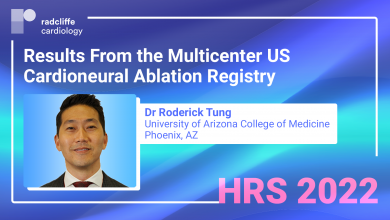Search results
Pacing for Vasovagal Syncope
Author(s):
Rakesh Gopinathannair
,
Benjamin C Salgado
,
Brian Olshansky
Added:
3 years ago
Article
Author(s):
Satish Raj
,
Robert Sheldon
Added:
3 years ago
Syncope and palpitations are two common clinical presentations, and both pose difficulties in the approach to their management. They are both symptoms of a number of syndromes, and an efficient approach with targeted therapy is challenging. Cardiac arrhythmia specialists, who lack a compact and accessible guide to management, see many patients with these symptoms in consultation. Recognising this…
View more
Author(s):
Stavros Stavrakis
,
Sunny Po
Added:
3 years ago
There are numerous conglomerations of autonomic ganglia on the epicardial surface of the heart, known as ganglionated plexi (GP). These GP have been shown to play a significant role in different arrhythmias, including AF. As such, GP ablation has become an adjunctive procedure in the treatment of AF. This review will present the current data on the significance of GP in arrhythmogenesis and will…
View more
Author(s):
Richard Sutton
Added:
3 years ago
Syncope in a patient with a pacemaker commands urgent action to ascertain its cause and provide appropriate treatment. This is a well accepted statement but the field has evolved in recent years and, strangely, has received little attention.
Many considerations bear on this issue. First, syncope in pacemaker patients is not common but may be more so than generally considered. The lack of…
View more
Author(s):
JC Pachon
Added:
3 years ago
Dear Sir,
In December, Dr Stavrakis and Dr Po published the excellent article “Ganglionated Plexi Ablation: Physiology and Clinical Applications” in AER.1 Despite the outstanding quality, unfortunately the article presents a very small fault.
The authors state that autonomic ablation for the treatment of bradyarrhythmias was proposed by Yao. GP ablation for vasovagal syncope was first…
View more
Author(s):
Roderick Tung
Added:
1 year ago
In this short interview, Dr Roderick Tung (University of Arizona College of Medicine, Phoenix, AZ, US.) joins us at HRS 2022 to outline the findings from a multicenter US cardioneural ablation registry in a study designed to provide data on the safety and feasibility of catheter-based cardioneural ablation.
Discussion Points:
1. Aim of this study
2. Patient population, study design and endpoints…
View more
Author(s):
Stavros Stavrakis
,
Sunny Po
Added:
3 years ago
Dear Sir,
We thank Dr Pachon for his interest in our manuscript.1 While we acknowledge that the concept of autonomic ablation for treatment of bradyarrhythmias was first proposed by Dr Pachon’s group,2,3 we would like to draw the reader’s attention to the methods of identifying the ganglionated plexi (GP). The original description by Dr Pachon’s group was based on Fast-Fourier Transform (FFT)…
View more
Cardiac Pacing in Reflex Syncope
Author(s):
Marco Tomaino
,
Vincenzo Russo
,
Daniele Giacopelli
,
et al
Added:
2 years ago
Article












